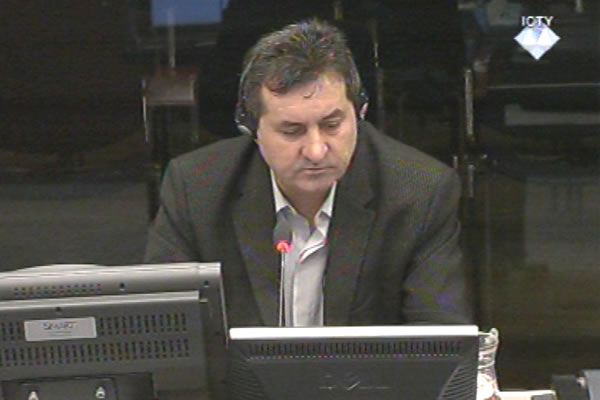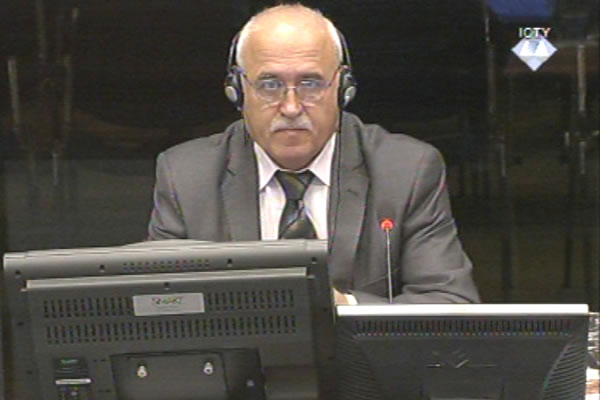Home
‘VOLUNTARY EVACUATION’ FROM SANSKI MOST AND KLJUC
Mikan Davidovic from Sanski Most claimed at Karadzic’s trial that ‘no-one ever’ forced the non-Serbs to leave the municipality, although he lived in a village 20 km away from the town of Sanski Most and he admitted he didn’t know what was going on in other parts of the municipality. Former member of the Kljuc Crisis Staff Rajko Kalabic claimed that Karadzic didn’t participate in forming the municipal authorities, only to confirm in the cross-examination that it was not entirely the case
 Mikan Davidovic, witness at the Radovan Karadzic trial
Mikan Davidovic, witness at the Radovan Karadzic trial During the war Mikan Davidovic from Sanski Most was a member of the Committee for smooth departure of non-Serbs from the municipality. In a statement he gave to Radovan Karadzic’s defense, Davidovic said that ‘no-one ever’ forced the non-Serbs to leave the municipality. As he said, they left voluntarily and Davidovic ‘helped’ them by providing them with the documents and means of transport to ensure their ‘smooth’ departure to third countries.
Prosecutor Amir Zec put it to him in the cross-examination that after the Serb authorities gained control of Sanski Most in April 1992, they in fact ‘made every effort’ to make as many Muslims and Croats as possible leave in order to ensure the ‘Serb majority’. The result of their efforts was that only about 4,000 Muslims and about 1,000 Croats remained in Sanski Most in 1993. Before the war, 28,000 Muslims and about 4,000 Croats lived in the municipality.
Davidovic was a member of the 1993 census commission but found it ‘difficult to speak about numbers’. He explained that until the second half of 1993 he lived in Bosanski Milanovac, about 20 km from Sanski Most. For the same reason Davidovic was not able to tell the prosecutor about the threats to the non-Serbs, the destruction of their houses and the mass murder of Muslims in Mahala and other places. In light of his ignorance, the prosecutor concluded, the witness was not in a position to give reliable evidence about the purported ‘voluntary’ departure of non-Serbs in 1992.
Karadzic’s next witness was Rajko Kalabic, war-time member of the Crisis Staff in Kljuc. Kalabic also claimed that there was no pressure on the non-Serbs to move out of the municipality. In his statement to the defense Kalabic said that the Crisis Staff dealt with logistic issues only. Karadzic ‘didn’t have any influence on the formation of government in Kljuc and on the election of local officials before or after the war’. Karadzic ‘never ordered, committed or aided and abetted the war crimes against non-Serbs in BH’, Kalabic stated.
Prosecutor Bronagh McKenna noted in the cross-examination that the Crisis Staff in Kljuc was created on the instructions of the SDS Main Board on 19 December 1991. The instructions were known as Variant A and B. This is corroborated by the minutes of a meeting of municipal leaders in late December 1991 when the decision to create the crisis staff was made. This was done as part of the implementation of Variant A, the prosecutor said, and the witness confirmed it.
Kalabic admitted that the War Presidency in Kljuc was established in July 1992 in line with Karadzic’s instructions. This was contrary to Kalabic’s claim that Karadzic didn’t have any influence on the formation of municipal authorities, the prosecutor observed.
Photos
Linked Reports
- Case : Karadzic
- 2013-12-04 NON-SERBS WERE TREATED ‘PROFESSIONALLY, HUMANELY AND FAIRLY’
- 2013-12-04 COMPULSORY WORK SERVICE TO MAKE NON-SERBS ‘FEEL USEFUL’
- 2013-12-03 ‘OUTSTANDING INTELLIGENCE OFFICER’ KNEW NOTHING
- 2013-12-06 PEOPLE MOVED OUT OF SANSKI MOST VOLUNTARILY, NOT BECAUSE THEY WERE FORCED TO
- 2013-12-08 KARADZIC FEARS THAT AMERICA EAVESDROPS ON HIM IN THE HAGUE
- 2013-12-09 ‘HUMANITARIAN’ AGENCY ORGANIZED EXODUS

